Resiliency Analysis of Hybrid Energy Systems within Interconnected Infrastructures
Abstract
:1. Introduction
2. HES within Interconnected Infrastructures
3. Proposed Resiliency Analysis Framework
3.1. Independent Resiliency Layers
- Inherence resiliency design (IRD);
- Resiliency control system (RCS);
- Resiliency alarms management (RAM);
- Resiliency interlock systems (RIS).
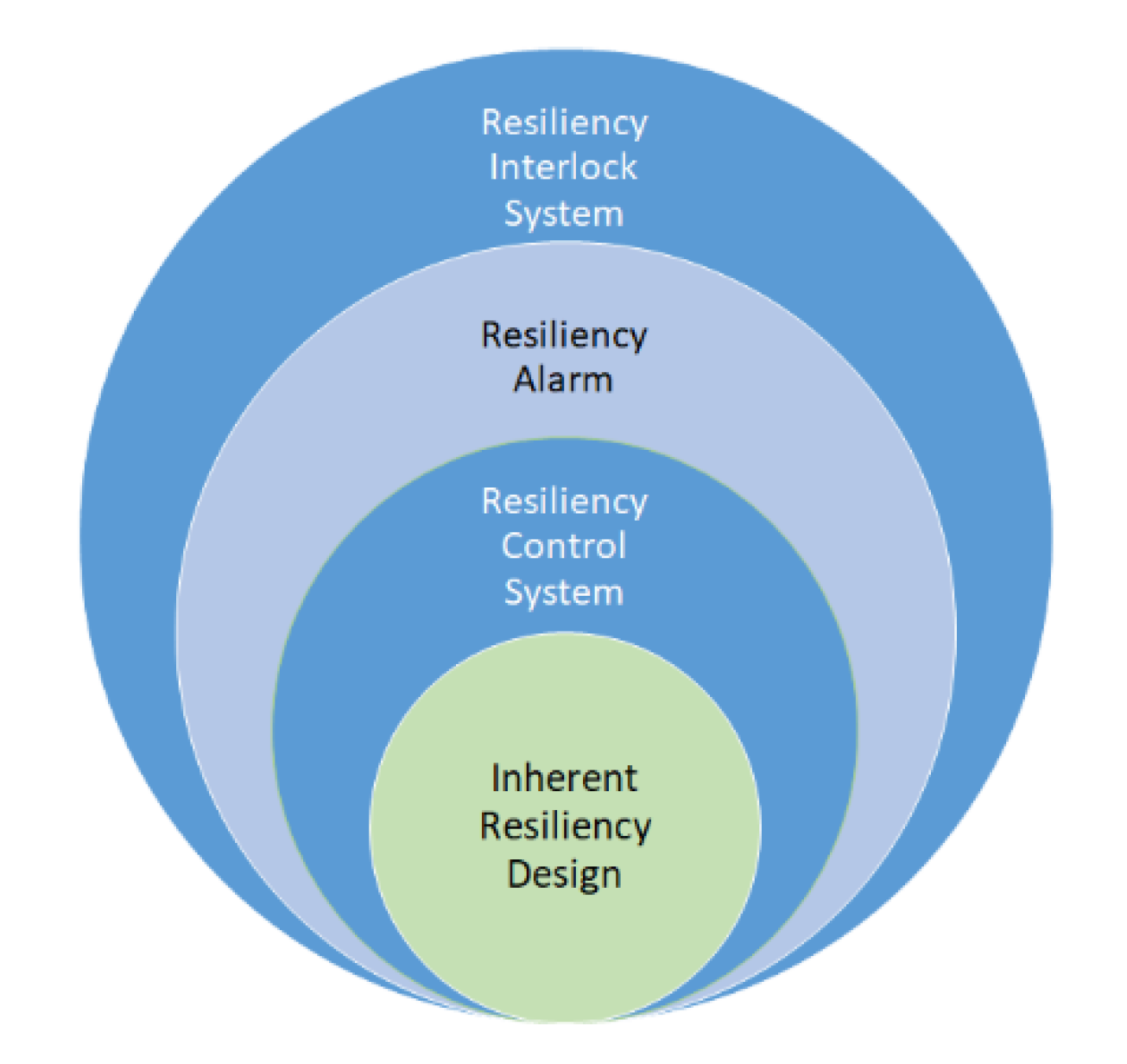
3.1.1. Inherent Resiliency Design (IRD)
3.1.2. Resilient Control System (RCS)
3.1.3. Resiliency Alarm Management (RAM)
3.1.4. Resiliency Interlock Systems (RIS)
4. Resiliency System Design
5. Resiliency Analysis
5.1. Resiliency Causation Scenarios
5.2. Resiliency Performance Estimation
5.3. Resiliency Performance Coupling
- : total KPI for the whole interconnected systems;
- ;
- ;
- ;
- ;
- ;
- ;
- ;
- ;
- ;
- ;
- ;
- .
6. Conclusions
Funding
Institutional Review Board Statement
Informed Consent Statement
Data Availability Statement
Acknowledgments
Conflicts of Interest
References
- Gabbar, H. Modeling of Interconnected Infrastructures with Unified Interface Design Toward Smart Cities. Energies 2021, 14, 4572. [Google Scholar] [CrossRef]
- Craig, G.; Eilín, W.; Kevin, M.; Philip, O. Regional Integration of Renewable Energy Systems in Ireland The Role Of Hybrid Energy Systems for Small Communities. Int. J. Electr. Power Energy Syst. 2013, 44, 713–720. [Google Scholar]
- Marcus, L.; Anne Marie, O.; Robert, D.; Martin, L.T.; Valerie, C.V. Governance Barriers to Sustainable Energy Transitions—Assessing Ireland’s Capacity towards Marine Energy Futures. Energy Policy 2018, 113, 623–632. [Google Scholar]
- Diab, F.; Lan, H.; Ali, S. Novel Comparison Study between The Hybrid Renewable Energy Systems on Land and on Ship. Renew. Sustain. Energy Rev. 2016, 63, 452–463. [Google Scholar] [CrossRef]
- Ustun, T.S.; Ozansoy, C.; Zayegh, A. Modeling of a Centralized Microgrid Protection System and Distributed Energy Resources according to IEC 61850-7-420. IEEE Trans. Power Syst. 2012, 27, 1560–1567. [Google Scholar] [CrossRef]
- Arash, B.; Kieran, P.D.; Richard Geddes, R.; Oliver Gao, H. Climate-Adaptive Planning for The Long-Term Resilience of Transportation Energy Infrastructure. Transp. Res. Part E Logist. Transp. Rev. 2018, 113, 99–122. [Google Scholar]
- Heng, C.X.; Ju, H.P.; Peng, S. Fuzzy Resilient Energy-To-Peak Filtering for Continuous-Time Nonlinear Systems. IEEE Trans. Fuzzy Syst. 2017, 25, 1576–1588. [Google Scholar]
- Nik, V.M.; Perera, A.T.D.; Chen, D. Towards Climate Resilient Urban Energy Systems: A Review. Natl. Sci. Rev. 2021, 8, 134. [Google Scholar] [CrossRef] [PubMed]
- Hamilton, M.C.; Lambert, J.H.; Connelly, E.B.; Barker, K. Resilience Analytics with Disruption of Prefer-Ences And Lifecycle Cost Analysis for Energy Microgrids. Reliab. Eng. Syst. Saf. 2016, 150, 11–21. [Google Scholar] [CrossRef]
- Fathima, A.H.; Palanisamy, K. Optimization in Microgrids With Hybrid Energy Systems—Review. Renew. Sustain. Energy Rev. 2015, 45, 431–446. [Google Scholar] [CrossRef]
- Arghandeh, R.; Uzunoglu, B.; D’arco, S.; Ozguven, E.E. Data Driven Reliable and Resilient Energy System against Disasters. IEEE Trans. Ind. Inform. 2021, 1. [Google Scholar] [CrossRef]
- Chao, D.; Yu, W.; Changyun, W.; Yan, X.; Pengfeng, L. Distributed Resilient Control for Energy Storage Systems in Cyber-Physical Microgrids. IEEE Trans. Ind. Inform. 2021, 17, 1331–1341. [Google Scholar]
- Kexing, L.; Illindala, M.S. A Distributed Energy Management Strategy for Resilient Shipboard Power System. Appl. Energy 2018, 228, 821–832. [Google Scholar]
- Georgescu-Roegen, N. The Entropy Law and the Economic Process; Harvard University Press Partnered With De Gruyter: Cambridge, MA, USA, 1971; ISBN 9780674281653. [Google Scholar]

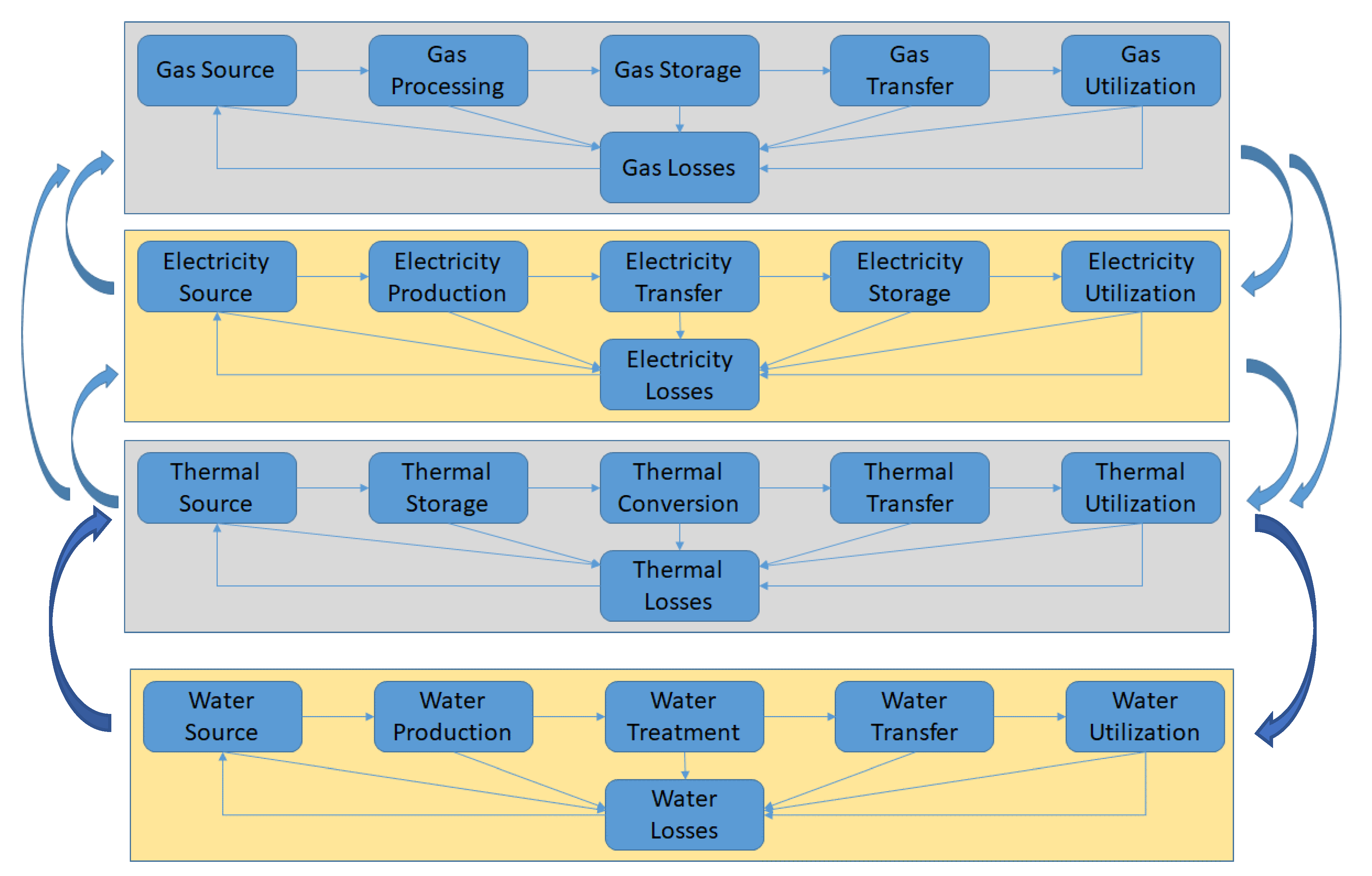
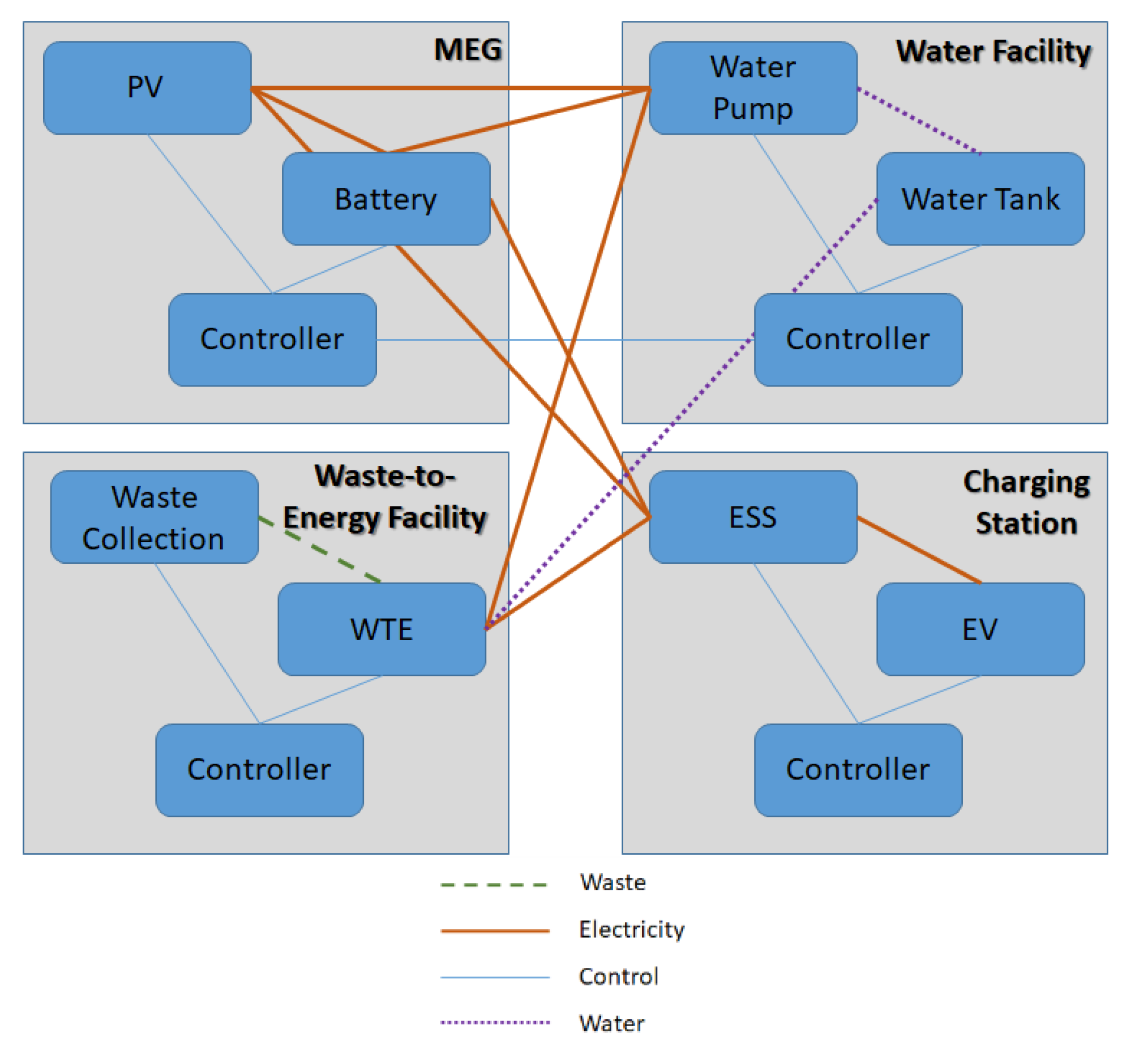

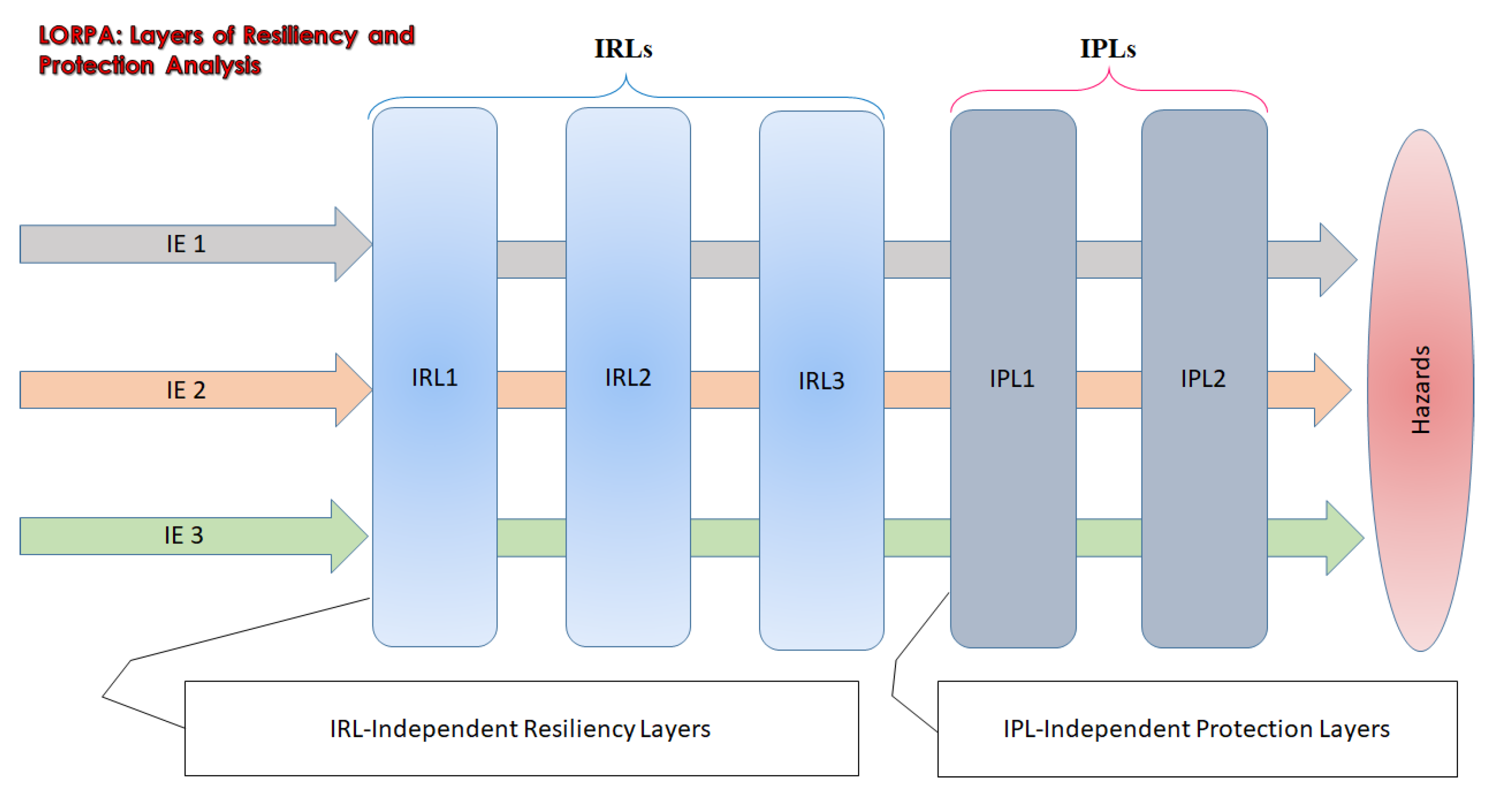

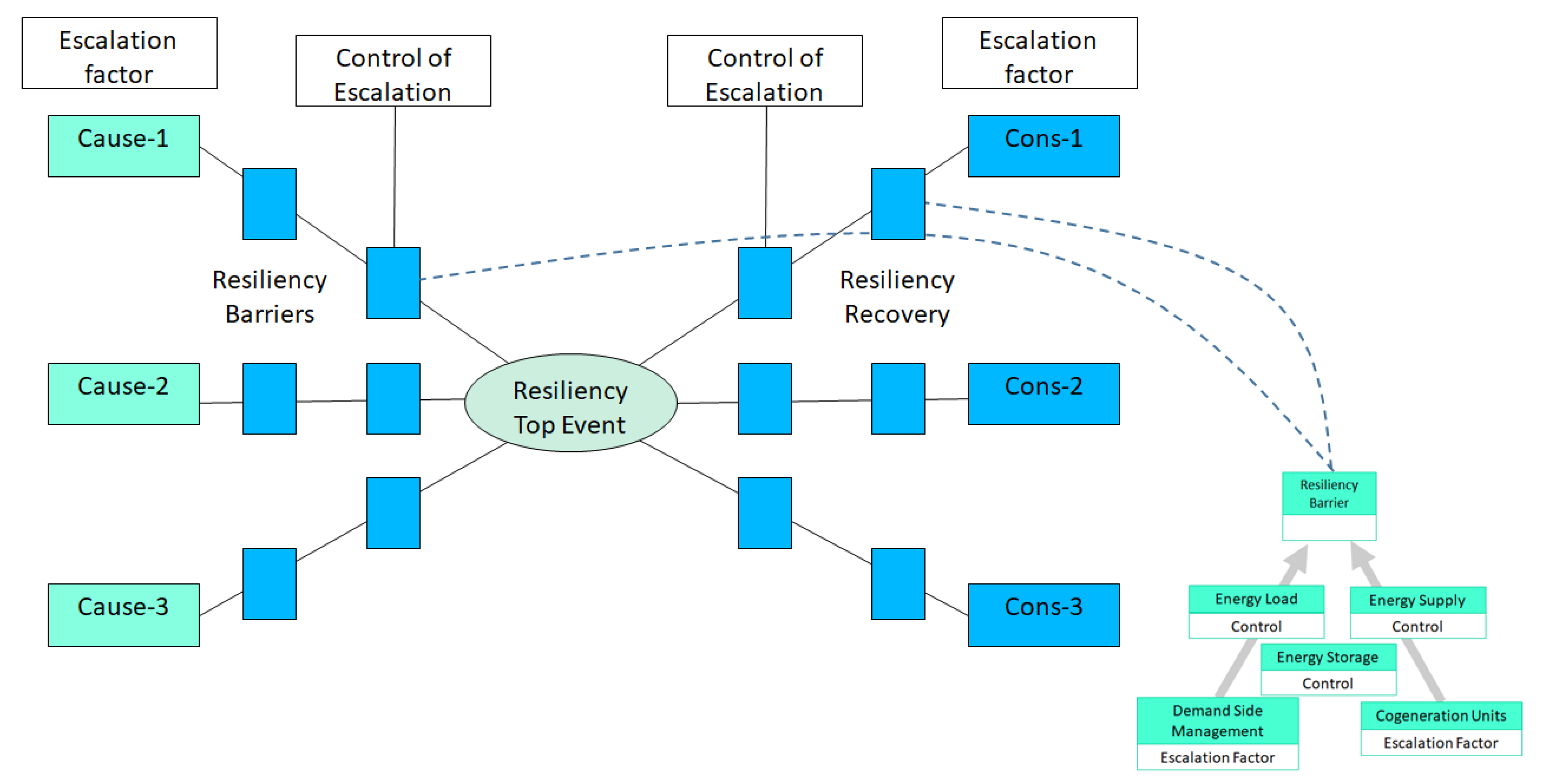
| Resiliency Limits of Energy Load | Electricity, Thermal, Gas/Hydrogen |
|---|---|
| Resiliency Limits of Energy Supply | Electricity, Thermal, Gas/Hydrogen |
| Resiliency Limits of Energy Storage | Electricity, Thermal, Gas/Hydrogen |
| Resiliency Limits of Water Load | Energy-Water Interconnected Systems |
| Resiliency Limits of Water Supply | Energy-Water Interconnected Systems |
| Resiliency Limits of Water Storage | Energy-Water Interconnected Systems |
| Causes | Consequences | Possible Resiliency Layers |
|---|---|---|
| 1. Demand related scenarios | ||
| 1.1. Increase in energy demand | Energy not served | Demand side management |
| Deterioration of energy systems | Increase energy storage | |
| Increased energy price from grid | Increase cogeneration | |
| Scheduled/interrupted energy supply | Increase energy conversion | |
| Activate protection layers | ||
| 1.2. Decrease in energy demand | Higher load on grid | Activate protection layers |
| Deterioration of energy systems | Increase energy storage | |
| Increase maintenance | ||
| 1.3. Fluctuation of energy demand | Same as increase/decrease in energy demand | |
| 2. Supply related scenarios | ||
| 2.1. Increase in energy supply | Higher load on grid | Activate protection layers |
| Deterioration of energy systems | Increase energy storage | |
| Increase maintenance | ||
| 2.2. Decrease in energy supply | Energy not served | Demand side management |
| Deterioration of energy systems | Increase energy storage | |
| Increased energy price from grid | Increase cogeneration | |
| Scheduled/interrupted energy supply | Increase energy conversion | |
| Activate protection layers | ||
| 2.3. Fluctuation in energy supply | Same as increase/decrease in energy supply | |
| 2.4. Increase in energy supply price | With limited budget, less cover to demand | Increase energy storage |
| 2.5. Decrease in energy supply price | Reduced profits of energy system owners | Increase energy storage |
| 2.6. Fluctuation in energy supply price | Same as increase/decrease in energy supply price | |
| 3. External Factors | ||
| 3.1. Earthquake/flood/storm | Damage to energy supply | Same as 2.2. |
| Damage to energy storage | Demand side management to close gap between supply and demand | |
| Increase energy supply | ||
| Increase energy storage | ||
| Damage to energy loads | Fix issues with damaged loads | |
| Same as 2.1. | ||
| 3.2. Special events | Increase in energy demand | Same as 1.1. |
| 3.3. Terror/Hacking | Damage to energy supply | Same as 2.2. |
| Damage to energy storage | Demand side management to close gap between supply and demand | |
| Increase energy supply | ||
| Increase energy storage | ||
| Damage to energy loads | Fix issues with damaged loads | |
| Same as 2.1. | ||
| 4. Impacts from Interconnected Systems | ||
| 4.1. Increase in water demand | Increase in energy demand (needed for water pumps and networks) | Same as 1.1. |
| 4.2. Decrease in water demand | Decrease in energy demand | Same as 1.2. |
| 4.3. Increase in transportation demand | Increase in energy demand (needed for increased EV) | Same as 1.1. |
| 4.4. Decrease in transportation demand | Decrease in energy demand | Same as 1.2. |
| 4.5. Increase in waste | Increase in energy supply (as output from waste-to-energy) | Same as 2.1. |
| 4.6. Decrease in waste | Decrease in energy supply | Same as 2.2. |
| 4.7. Increase in food demand | Increase in energy demand for processing food production/supply | Same as 1.1. |
| 4.8. Decrease in food demand | Decrease in energy demand | Same as 1.2. |
| 4.9. Increase in health demand | Increase in energy demand (to support health systems) | Same aas 1.1. |
| 4.10. Decrease in health demand | Decrease in energy demand | Same as 1.2. |
| 4.11. Increase in social demand | Possible increase in energy demand (to support mobility) | Same as 1.1. |
| 4.12. Decrease in social demand | Possible decrease in energy demand | Same as 1.2. |
| 4.13. Decrease in human performance | Possible deterioration of energy systems (with reduced operation and maintenance) | Activate protection layers |
| Increase maintenance | ||
| Increase energy storage | ||
| Increase energy supply | ||
| 4.14. Decrease in system performance | Possible deterioration of energy systems | Activate protection layers |
| Increase maintenance | ||
| Increase energy storage | ||
| Increase energy supply | ||
| 4.15. Change in geopolitical | Possible reduction of energy supply | Same as 2.2. |
| Disturbance | Start Time | Return Time | P-Reached | P-Ideal | Response | P-Gap | Resilience | Resilience-1 | Resilience-2 | Net Resilience |
|---|---|---|---|---|---|---|---|---|---|---|
| number | t1 | t2 | d1 | d2 | t2 − t1 | |d1 − d2| | R′ | R1 | R2 | R |
| 1 | 2 | 5 | 82 | 90 | 3 | 8 | 4.17 | 91.11 | 40 | 50.22 |
| 2 | 2 | 4 | 82 | 90 | 2 | 8 | 6.25 | 91.11 | 50 | 58.22 |
| 3 | 2 | 5 | 80 | 90 | 3 | 10 | 3.33 | 88.89 | 40 | 49.78 |
| 4 | 2 | 4 | 80 | 90 | 2 | 10 | 5.00 | 88.89 | 50 | 57.78 |
Publisher’s Note: MDPI stays neutral with regard to jurisdictional claims in published maps and institutional affiliations. |
© 2021 by the author. Licensee MDPI, Basel, Switzerland. This article is an open access article distributed under the terms and conditions of the Creative Commons Attribution (CC BY) license (https://creativecommons.org/licenses/by/4.0/).
Share and Cite
Gabbar, H.A. Resiliency Analysis of Hybrid Energy Systems within Interconnected Infrastructures. Energies 2021, 14, 7499. https://doi.org/10.3390/en14227499
Gabbar HA. Resiliency Analysis of Hybrid Energy Systems within Interconnected Infrastructures. Energies. 2021; 14(22):7499. https://doi.org/10.3390/en14227499
Chicago/Turabian StyleGabbar, Hossam A. 2021. "Resiliency Analysis of Hybrid Energy Systems within Interconnected Infrastructures" Energies 14, no. 22: 7499. https://doi.org/10.3390/en14227499
APA StyleGabbar, H. A. (2021). Resiliency Analysis of Hybrid Energy Systems within Interconnected Infrastructures. Energies, 14(22), 7499. https://doi.org/10.3390/en14227499






